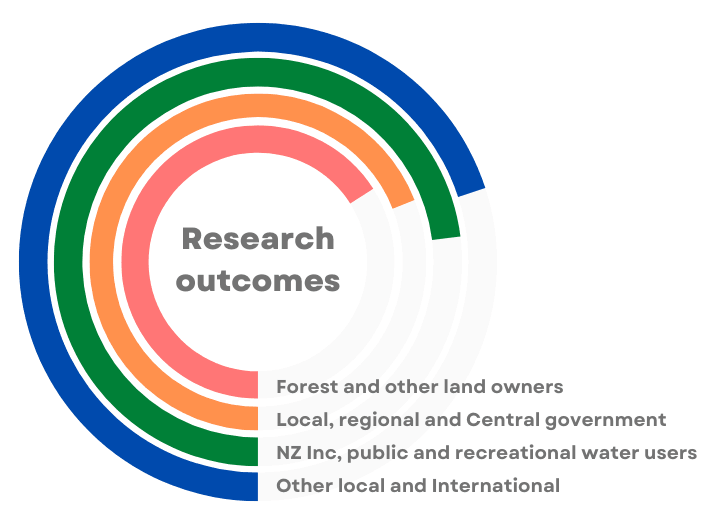Delivering benefits for New Zealand and New Zealanders
Problems
- More intensive agriculture, irrigation, population growth and urbanisation increasing demand for freshwater resources.
- Floods and droughts that affect water quantity are increasingly likely, due to environmental factors (e.g. climate change). Water quality is also being degraded by pollution, especially from intensive agriculture.
- We don't know how forests affect water resources, especially during droughts, yet large scale afforestation is planned through the Governments 1 Billion Trees (1BT) programme
- Current estimates of water supply from forests are woefully inaccurate because they are based on limited information obtained using outdated assumptions (not accounting for the above issues).
- Forests are increasingly seen as competing for water resources, and having a negative impact on waterways.
Beneficiaries

Forest and land owners
- Provide a decision making framework to help landowners evaluate decisions for managing planted forests and water for existing forests and new plantings
- Quantify planted forest water ecosystem services for stormflow mitigation and low-flow water supply
- Provide license to operate
- Compare planted forest water use with other land uses
Local, regional and Central government
- Use existing and new forests for water security to urban and other rural users
- Identify areas that would benefit from specific types of afforestation now and in the future
NZ Inc, public and recreational water users
- Provide a paradigm shift in hydrological research for planted forests and other land uses
- Generate world-leading, new methodology so New Zealand is at the forefront of this research
Summary of benefits to New Zealand
The outputs of this research will:
- Protect primary-sector productivity and improve water quality, flood mitigation, and current/future demands for rural/urban users, by quantifying water storage/release by planted forests
- Quantify the positive and negative impacts of planted forests on water resources, including any potential impacts resulting from intensification of planted-forest productivity
- Determine whether some tree species and planted forest types are better at flood mitigation than others
- Identify planted forests that have the potential to be passive water-reservoir systems and thereby reduce the number/size of irrigation schemes in their area
Engagement approach

Using a variety of mechanisms we will communicate and liaise with as well as gather feedback from a wide range of stakeholders, focused on enabling a two way exchange of knowledge, insights and research.
Next-user engagement
We will use case studies to demonstrate the applicability of the look-up tables, biophysical model and assessment tool for decision making. We will also leverage our engagement with the regional councils, LMF and others to demonstrate and promote the applicability of the project outputs to other land owners, regional/central government agencies, Māori, non-government organisations, and scientists.
“Summit Forests NZ Limited manages Te Hiku plantation forest on land collectively owned by four Te Tai Tokerau iwi (Te Aupōuri, Ngāti Kuri, Ngāi Takoto and Te Rarawa). Summit is dedicated to managing the land in an environmentally, culturally, socially and economically sustainable manner. We welcome Scion’s research focused on flows from this forest and hope it will help plug some of the hydrological knowledge gaps. In the future the information gathered may be able to provide sound science to management decisions, particularly around wetland setbacks.”
Karen Lucich, Environmental Planner, Summit Forests NZ Ltd
“Ngai Tahu Forestry are pleased to partner with Scion on their research project to better understand how plantation forestry impacts the flow and quality of water both within and beyond their forest estate. This project reflects the increasing importance being placed on the protection of our natural resources and ecosystems and Ngai Tahu envisage that the information obtained through the course of this programme has the potential to enhance and strengthen their own beliefs and values with respect to the protection of the land in perpetuity.”
Chris Calder, Operations Manager, Ngāi Tahu Forestr
“New Zealand’s planted forests are part of a mosaic of land cover, and the relationships between our planted forests and the flow of water in and out of them and the consequent impact on and interaction with the wider receiving environments are not always well understood. Yet water use and flow dynamics are fast becoming a major issue affecting forest owners’ licence to operate – both as a result of major rainfall events, and in increasingly dry areas. In drier areas such as Otago, regulators are starting to single out plantation forestry for land use restrictions, and this seems to be based on research that relies on a small number of sometimes quite unrepresentative studies. Scion’s Forest Flows research programme promises to significantly advance our understanding of in-forest and catchment flow dynamics, and should deliver robust modelling tools to back up the positive impact of our plantation activities.”
Peter Oliver, General Manager, Forest Assets, City Forests Ltd






